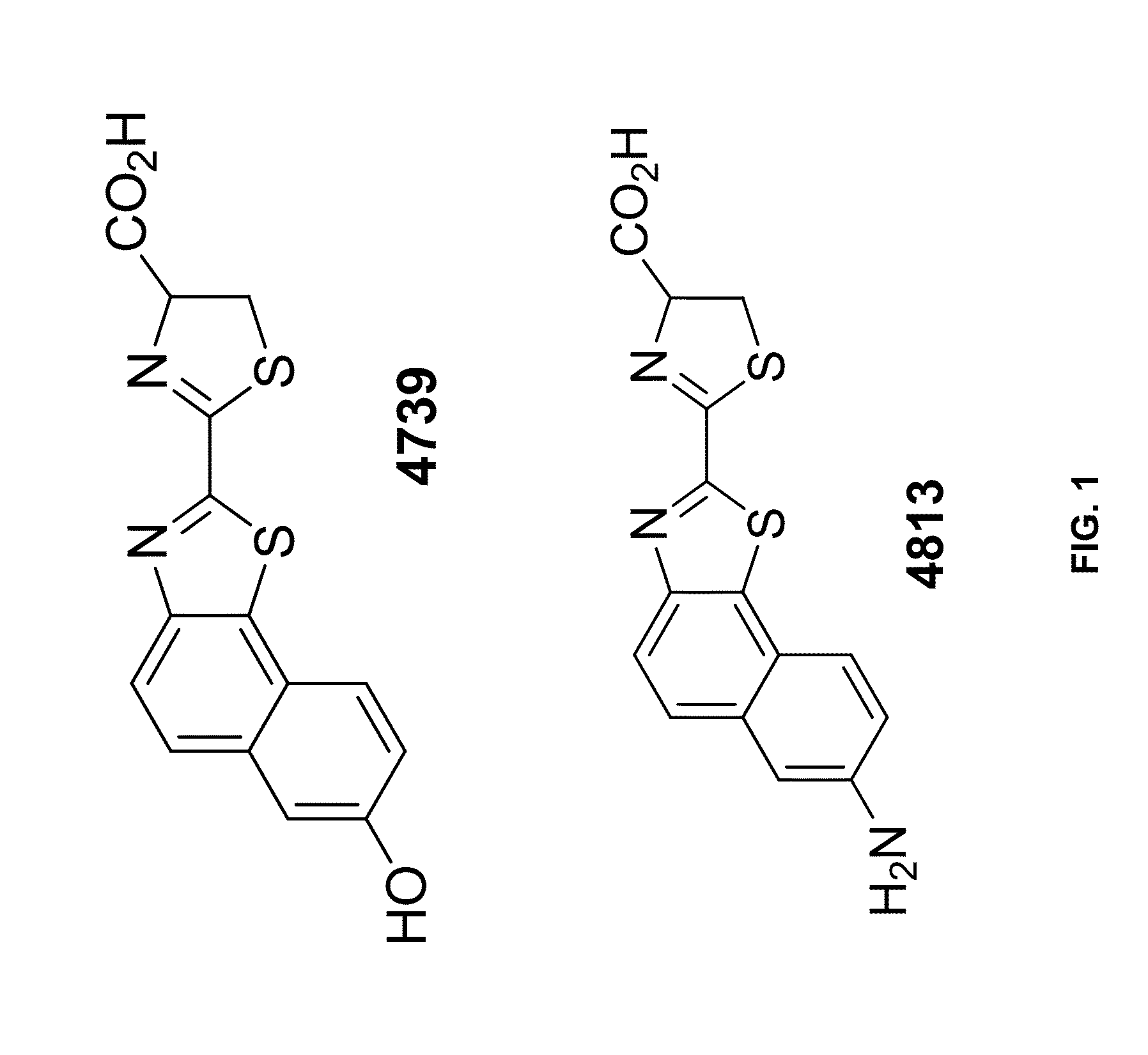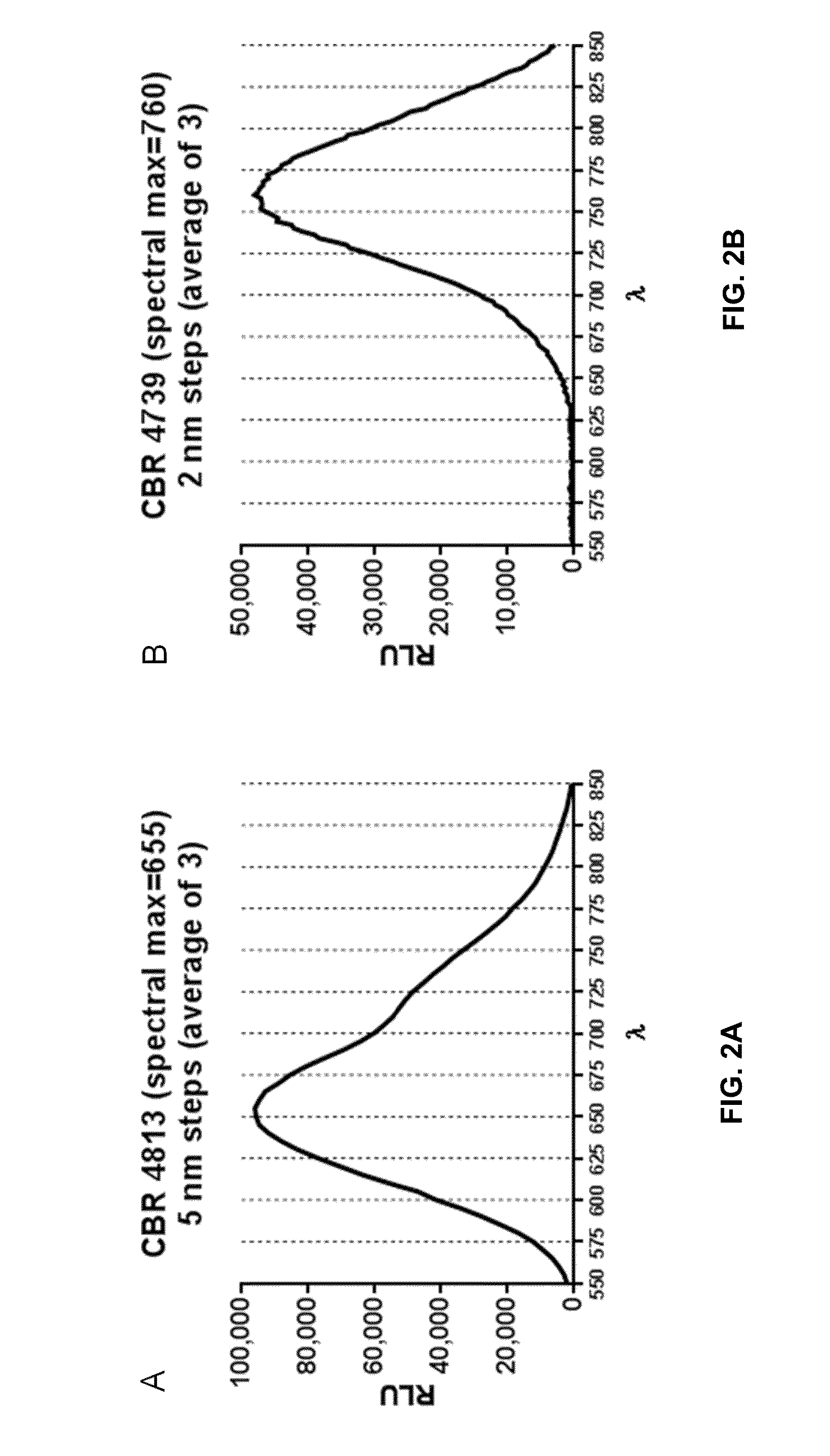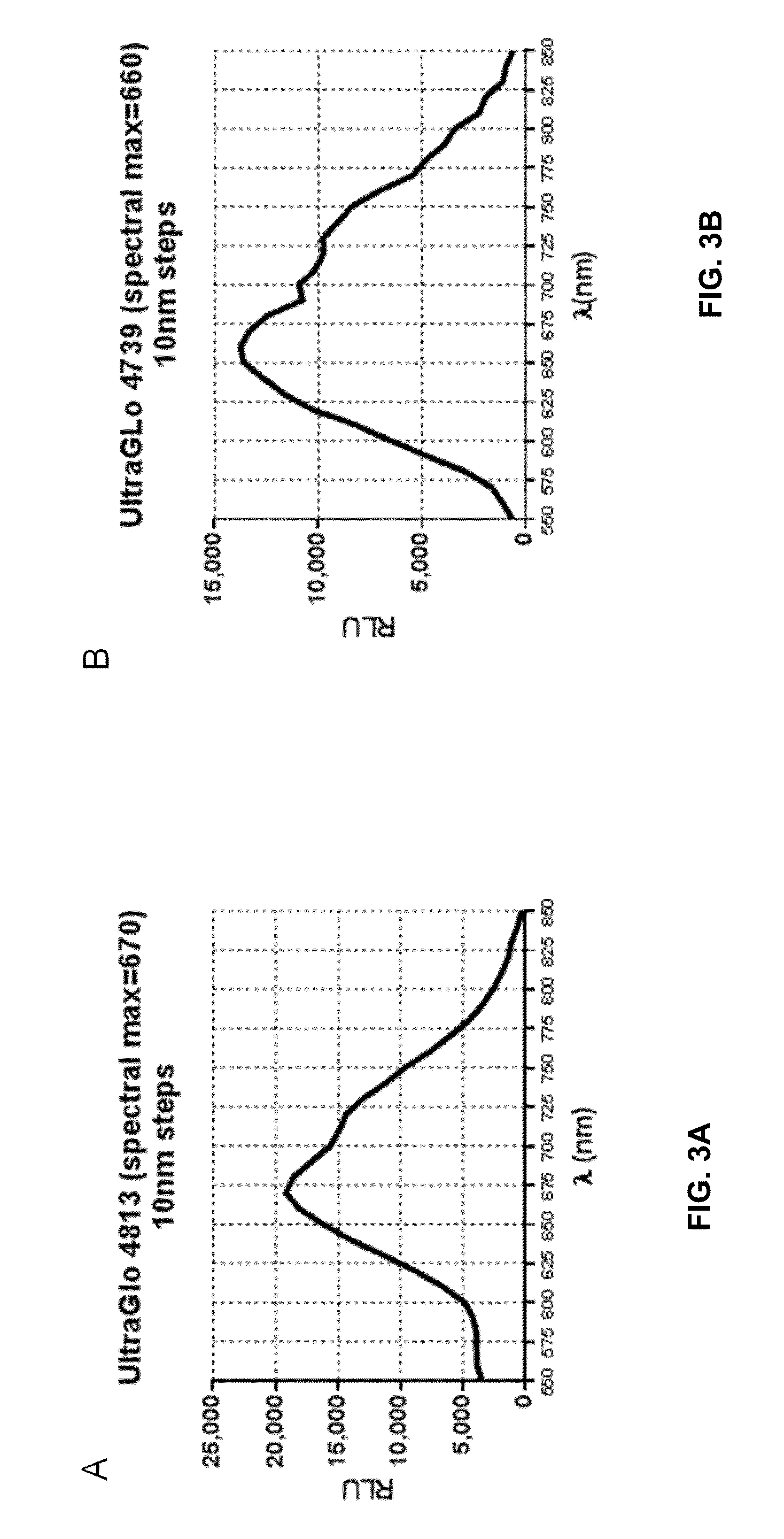Novel luciferase sequences utilizing infrared-emitting substrates to produce enhanced luminescence
a luciferase and infrared-emitting substrate technology, applied in the field of infrared-emitting substrates for infrared-emitting substrates, can solve the problems of limited utility of whole-animal optical imaging, limited light penetration by the absorption coefficient of particular components in blood, and limited tissue penetration limitations
- Summary
- Abstract
- Description
- Claims
- Application Information
AI Technical Summary
Benefits of technology
Problems solved by technology
Method used
Image
Examples
example 1
Characterization of Near-IR Substrates PBI-4739 and PBI-4813 with Ultra-Glo™ Luciferase, QuantiLum® Recombinant Luciferase, and Purified Click Beetle Red Luciferase (CBR)
[0307]Materials: The following were used in the Examples: Ultra-Glo™ Luciferase (Promega Cat. No. E140); QuantiLum® Recombinant Luciferase (Promega Cat. No. E1701); Click Beetle Red Luciferase (CBR; 0.5 mg / mL purified; Promega); Bright-Glo™ assay buffer (Promega Cat. No. E264A); PBI-4739 (Promega—See FIG. 1); and PBI-4813 (Promega—See FIG. 1).
[0308]Experimental Details. The substrates, PBI-4813 and PBI-4739, were diluted to 1 mM (final concentration) in Bright-Glo™ Assay buffer+1 mM ATP. 50 μL of substrate solution was added to 50 μL of Click Beetle Red, UltraGlo® or QuantiLum® purified enzyme (0.5 mg / mL diluted in DMEM+0.1% Prionex) in triplicate, and then the samples assayed using a Tecan M-1000 plate reader in spectral scan mode.
[0309]FIG. 2 provides the spectral data for Click Beetle Red Luciferase with PBI-4813...
example 2
Library Screening
[0310]A library of Click Beetle Red variants was prepared using the Diversify™ PCR Random Mutagenesis Kit (Clontech) according to the manufacturer's instructions using pF4Ag-HT7-CBR as a template, i.e., CBR-HALOTAG® fusion protein. The library of variant DNA was cloned into the pF4Ag-HT7 (Promega) and transformed into 50 μL KRX competent cells (Promega Corporation). The cells were grown overnight on LB-ampicillin plates at 37° C.
[0311]Colonies were picked and grown overnight at 37° C. in 200 μL of M9-minimal media (1× M9 salts, 0.1 mM CaCl2, 2 mM MgSO4, 1 mM Thiamine-HCL, 1% gelatin, 0.2% glycerol and 100 μg / mL Ampicillin) in wells of 96-well plates. 10 μL of the overnight culture was diluted into 190 μL M9-minimal media and grown overnight at 37° C. 10 μL of the second overnight culture was diluted into 190 μL M9-minimal induction media (M9 minimal media+0.05% glucose and 0.02% rhamnose) and grown overnight at 25° C.
[0312]The cells were assayed via a robot. Briefly...
example 3
Click Beetle Red Mutation Combinations
[0313]Some of the mutations identified in the library screen outlined in Example 2 were combined to identify beneficial combinations of mutations. The mutations were introduced into the Click Beetle Red (CBR) luciferase (SEQ ID NO: 1) using the QuikChange Multi Site-Directed Mutagenesis Kit (Agilent). Variants were cloned, expressed and screened as described in Example 2. Table 2 and FIG. 5 list the variants and their fold change in luminescence over CBR luciferase with the substrate PBI-4813 or PBI-4739.
TABLE 2Sample sequenceSamplePBI-4813PBI-4739I389F + S444RATG 10782.482.19I79V + I389F + I309T11G112.471.98G251SATG 10232.281.27I370T + I389F + I409T11A82.161.81I79V + I370T + I389F11C41.881.55I389FATG 10321.821.48S444RATG 10201.681.87I370T + I389F1G111.421.17WTWT1.061.05WTWT1.051.08WTWT1.041.02WTWT1.041.06
PUM
| Property | Measurement | Unit |
|---|---|---|
| bioluminescent light emission wavelengths | aaaaa | aaaaa |
| temperature | aaaaa | aaaaa |
| temperature | aaaaa | aaaaa |
Abstract
Description
Claims
Application Information
 Login to View More
Login to View More - R&D
- Intellectual Property
- Life Sciences
- Materials
- Tech Scout
- Unparalleled Data Quality
- Higher Quality Content
- 60% Fewer Hallucinations
Browse by: Latest US Patents, China's latest patents, Technical Efficacy Thesaurus, Application Domain, Technology Topic, Popular Technical Reports.
© 2025 PatSnap. All rights reserved.Legal|Privacy policy|Modern Slavery Act Transparency Statement|Sitemap|About US| Contact US: help@patsnap.com



